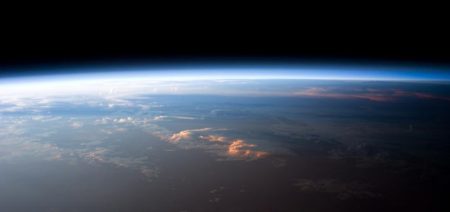February 8, 2018 – A research article appearing in a journal of the European Geosciences Union published this week provides evidence that thinning of the protective ozone layer appears to have moved from the poles where holes were observed in the past to the areas between 60 degrees north and south latitude. That pretty much constitutes everywhere humans and other life inhabit the planet. Very few of us live north and south of 60. That’s a problem.
The article, entitled Evidence for a continuous decline in lower stratospheric ozone offsetting ozone layer recovery, is a research collaboration involving scientists from the Physikalisch-Meteorologisches Observatorium Davos World Radiation Centre, Swiss Federal Institute of Technology Zurich, the Center for Computational Astrophysics, Flatiron Institute, New York, Imperial College London, Stockholm University, Hampton University, University of Saskatchewan, University of Colorado, Boulder, Earth System Research Laboratory, Boulder, NASA Goddard Space Flight Center, Greenbelt, Jet Propulsion Laboratory, Pasadena, Finnish Meteorological Institute, Georgia Institute of Technology, NOAA, Morgan State University, Baltimore, and others. In other words, this isn’t just a one-off observation, but rather a compilation of accumulative research with profound implications for our planet.
The key findings:
- Multiple satellite measurements show that ozone in the lower stratosphere between 60 degrees south and north have been in decline since 1998.
- While upper stratospheric ozone continues to recover, it is the continuing decline of ozone in the lower stratosphere that is being observed.
- For the moment increases in tropospheric ozone is compensating for the loss of ozone in the lower stratosphere.
- Reasons for the decline in the lower stratosphere remain unknown.
- No atmospheric models reproduce what is being observed in reality.
It’s the latter point that has the researchers concerned. If it can’t be modeled then it becomes hard to figure out if this is a natural phenomenon or human-caused.
For those readers less familiar with the composition of our atmosphere I provide a brief explanation.
The atmosphere consists of a number of layers. Where we humans and almost all life exists is in the troposphere. Here oxygen and water vapour are abundant, and the thickness of the air provides reasonable protection from cosmic and solar radiation.
The layer above the troposphere is the stratosphere. Stratus clouds, those icy wisps often called mare’s tails, form in the lower stratosphere. Where modern commercial jets fly is in the lower stratosphere. And in the stratosphere, a layer of trioxygen molecules made up of oxygen we cannot breathe, called ozone, blocks cosmic and solar radiation.
The other layers lying above the stratosphere include the near-space, mesosphere, above that, the thermosphere, and finally, the exosphere which takes us to a familiar space where near-Earth satellites and the International Space Station fly.
But getting back to the stratosphere, it was in the latter part of the 20th-century when ground-based atmospheric observations combined with satellites detected the thinning of ozone. Eventually the thinning became so pervasive, ozone-free holes opened near the Earth’s poles. Those holes grew to a point where Northern Europe, much of North America, Australia, South Africa and southern Argentina and Chile were exposed to cosmic and solar rays at levels previously not seen. That’s when scientists noted a sharp spike in skin cancers.
The search for a cause led to the discovery that the aerosol chemicals developed in commercial laboratories, used in air conditioning and in many spray-bottle products, was breaking down trioxygen. At a conference held in Montreal, Canada, the countries of the world agreed to ban the identified aerosol chemicals from commercial use. Decades later scientists could measure the recovery of stratospheric ozone over the poles.
Or at least scientists thought there was recovery until the findings of the research were published this week telling a very different story. Now what the researchers may have discovered is, that instead of ozone recovery the net increase at the poles has been offset by a thinning of ozone in the lower stratosphere over a wider swath of the planet.
The puzzle gets even more complex when the compiled data is studied further because it shows tropospheric ozone increasing for no explicable reason. The tropospheric ozone data set studied covers the last 13 years, and although this is a small sample in terms of time, the rise is notable.
So the picture the research shows is less ozone in the lower stratosphere, increases in the upper stratosphere, and increases in the troposphere with no easy explanation for the why.
Speculation points to three potential causes.
- The presence of unknown short-lived aerosols created by humans that interfere with ozone in the lower stratosphere.
- Global warming.
- Jet aircraft contrails.
The latter is not mentioned in the research paper but has often been considered as a pollution source that interferes with the normal chemical composition of the lower stratosphere. There have been a number of recent studies that link cloud formation with the presence of contrails. So why not ozone?









